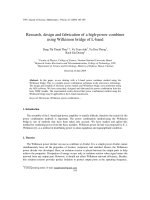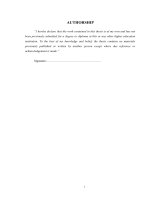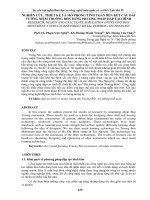Research design and methods a process approach 8th by bordens and abbott
Bạn đang xem bản rút gọn của tài liệu. Xem và tải ngay bản đầy đủ của tài liệu tại đây (3.92 MB, 628 trang )
www.downloadslide.com
Confirming Pages
Research Design
and Methods
A Process Approach
EIGHTH EDITION
Kenneth S. Bordens
Bruce B. Abbott
Indiana University—Purdue University Fort Wayne
bor32029_fm_i-xxii.indd i
6/4/10 8:13 PM
Confirming Pages
RESEARCH DESIGN AND METHODS: A PROCESS APPROACH, EIGHTH EDITION
Published by McGraw-Hill, a business unit of The McGraw-Hill Companies, Inc., 1221 Avenue of the
Americas, New York, NY 10020. Copyright © 2011 by The McGraw-Hill Companies, Inc. All rights reserved.
Previous editions © 2008, 2005, 2002. No part of this publication may be reproduced or distributed in any form
or by any means, or stored in a database or retrieval system, without the prior written consent of The McGrawHill Companies, Inc., including, but not limited to, in any network or other electronic storage or transmission,
or broadcast for distance learning.
Some ancillaries, including electronic and print components, may not be available to customers outside the
United States.
This book is printed on recycled, acid-free paper containing 10% postconsumer waste.
1 2 3 4 5 6 7 8 9 0 DOC/DOC 1 0 9 8 7 6 5 4 3 2 1 0
ISBN 978-0-07-353202-8
MHID 0-07-353202-9
Vice President & Editor-in-Chief: Michael Ryan
Vice President EDP/Central Publishing Services: Kimberly Meriwether David
Publisher: Mike Sugarman
Executive Editor: Krista Bettino
Managing Editor: Meghan Campbell
Executive Marketing Manager: Pamela S. Cooper
Senior Project Manager: Lisa A. Bruflodt
Buyer: Laura Fuller
Design Coordinator: Margarite Reynolds
Media Project Manager: Sridevi Palani
Indexer: Stephanie Abbott
Compositor: Laserwords Private Limited
Typeface: 10/12 Goudy
Printer: R. R. Donnelley
All credits appearing on page or at the end of the book are considered to be an extension of the copyright page.
Bordens, Kenneth S.
Research design and methods : a process approach / Kenneth S. Bordens, Bruce B. Abbott.–8th ed.
p. cm.
Includes bibliographical references and index.
ISBN 978-0-07-353202-8 (alk. paper)
1. Psychology–Research–Textbooks. 2. Psychology–Research–Methodology–Textbooks.
I. Abbott, Bruce B. II. Title.
BF76.5.B67 2011
150.72– dc22
2010009326
www.mhhe.com
bor32029_fm_i-xxii.indd ii
6/4/10 8:13 PM
Confirming Pages
We dedicate this book to our parents, who provided us with the opportunity and
inspiration to excel personally and professionally.
Lila Bordens and Walter Bordens
Irene Abbott and Raymond Abbott
bor32029_fm_i-xxii.indd iii
5/24/10 4:44 PM
This page intentionally left blank
Confirming Pages
CONTENTS
Preface
xvii
Chapter 1: Explaining Behavior
1
What Is Science, and What Do Scientists Do?
Science as a Way of Thinking 3
How Do Scientists Do Science? 3
Basic and Applied Research 4
Framing a Problem in Scientific Terms 5
2
Learning About Research: Why Should You Care?
Exploring the Causes of Behavior
6
7
Explaining Behavior 8
Science, Nonscience, and Pseudoscience 9
Scientific Explanations 11
Commonsense Explanations Versus Scientific Explanations 14
Belief-Based Explanations Versus Scientific Explanations 16
When Scientific Explanations Fail 17
Failures Due to Faulty Inference 17
Pseudoexplanations 19
Methods of Inquiry 21
The Method of Authority 21
The Rational Method 21
The Scientific Method 22
The Scientific Method at Work: Talking on a Cell Phone and the Ability to Drive 25
The Steps of the Research Process 26
Summary
Key Terms
29
31
Chapter 2: Developing and Evaluating Theories of Behavior
What Is a Theory? 32
Theory Versus Hypothesis
Theory Versus Law 34
32
33
v
bor32029_fm_i-xxii.indd v
5/24/10 4:44 PM
Confirming Pages
vi
Contents
Theory Versus Model 34
Mechanistic Explanations Versus Functional Explanations
Classifying Theories 38
Is the Theory Quantitative or Qualitative? 38
At What Level of Description Does the Theory Operate?
What Is the Theory’s Domain? 43
Roles of Theory in Science 43
Understanding 43
Prediction 44
Organizing and Interpreting Research Results
Generating Research 44
37
39
44
Characteristics of a Good Theory 46
Ability to Account for Data 46
Explanatory Relevance 46
Testability 46
Prediction of Novel Events 47
Parsimony 47
Strategies for Testing Theories 48
Following a Confirmational Strategy 48
Following a Disconfirmational Strategy 49
Using Confirmational and Disconfirmational Strategies Together
Using Strong Inference 49
Theory-Driven Versus Data-Driven Research
Summary
Key Terms
49
51
54
55
Chapter 3: Getting Ideas for Research 56
Sources of Research Ideas
Experience 57
Theory 60
Applied Issues 62
57
Developing Good Research Questions
Asking Answerable Questions 64
Asking Important Questions 65
63
Developing Research Ideas: Reviewing the Literature 66
Reasons for Reviewing the Scientific Literature 66
Sources of Research Information 67
Performing Library Research 77
The Basic Strategy 77
Using PsycINFO 78
Using PsycARTICLES 80
Other Computerized Databases
bor32029_fm_i-xxii.indd vi
80
5/24/10 4:44 PM
Confirming Pages
Contents
General Internet Resources 81
Computer Searching for Books and Other Library Materials
Other Resources 82
Reading a Research Report 83
Obtaining a Copy 83
Reading the Literature Critically
81
84
Factors Affecting the Quality of a Source of Research Information
Publication Practices 89
Statistical Significance 89
Consistency With Previous Knowledge 91
Significance of the Contribution 92
Editorial Policy 93
Peer Review 93
Values Reflected in Research 96
Developing Hypotheses
Summary
Key Terms
vii
88
98
99
101
Chapter 4: Choosing a Research Design
Functions of a Research Design
102
102
Causal Versus Correlational Relationships
103
Correlational Research 104
An Example of Correlational Research: Cell Phone Use and Motor
Vehicle Accidents 105
Behavior Causation and the Correlational Approach 105
Why Use Correlational Research? 106
Experimental Research 108
Characteristics of Experimental Research 109
An Example of Experimental Research: Cell Phone Use
While Driving 111
Strengths and Limitations of the Experimental Approach
Experiments Versus Demonstrations 113
112
Internal and External Validity 114
Internal Validity 114
External Validity 118
Internal Versus External Validity 119
Research Settings 120
The Laboratory Setting 120
The Field Setting 123
A Look Ahead 124
Summary
Key Terms
bor32029_fm_i-xxii.indd vii
124
126
5/24/10 4:44 PM
Confirming Pages
viii
Contents
Chapter 5: Making Systematic Observations 127
Deciding What to Observe
127
Choosing Specific Variables for Your Study
Research Tradition 128
Theory 128
Availability of New Techniques 129
Availability of Equipment 129
128
Choosing Your Measures 130
Reliability of a Measure 130
Accuracy of a Measure 132
Validity of a Measure 133
Acceptance as an Established Measure 134
Scale of Measurement 135
Variables and Scales of Measurement 137
Choosing a Scale of Measurement 138
Adequacy of a Dependent Measure 141
Tailoring Your Measures to Your Research Participants 143
Types of Dependent Variables and How to Use Them 144
Choosing When to Observe
148
The Reactive Nature of Psychological Measurement 149
Reactivity in Research with Human Participants 149
Demand Characteristics 150
Other Influences 151
The Role of the Experimenter 152
Reactivity in Research with Animal Subjects 156
Automating Your Experiments
157
Detecting and Correcting Problems
Conducting a Pilot Study 158
Adding Manipulation Checks
Summary
Key Terms
158
158
159
161
Chapter 6: Choosing and Using Research Subjects 162
General Considerations 162
Populations and Samples 163
Sampling and Generalization 164
Nonrandom Sampling 165
Is Random Sampling Always Necessary?
168
Acquiring Human Participants for Research 168
The Research Setting 169
The Needs of Your Research 170
Institutional Policies and Ethical Guidelines 170
bor32029_fm_i-xxii.indd viii
5/24/10 4:44 PM
Confirming Pages
Contents
Voluntary Participation and Validity 171
Factors That Affect the Decision to Volunteer
Volunteerism and Internal Validity 174
Volunteerism and External Validity 176
Remedies for Volunteerism 177
ix
171
Research Using Deception 178
Types of Research Deception 178
Problems Involved in Using Deception 179
Solutions to the Problem of Deception 181
Considerations When Using Animals as Subjects in Research
Contributions of Research Using Animal Subjects 186
Choosing Which Animal to Use 186
Why Use Animals? 187
How to Acquire Animals for Research 187
Generality of Animal Research Data 188
The Animal Rights Movement 189
Animal Research Issues 190
185
Alternatives to Animals in Research: In Vitro Methods
and Computer Simulation 194
Summary
Key Terms
195
196
Chapter 7: Understanding Ethical Issues in the Research Process 197
Ethical Research Practice With Human Participants 197
John Watson and Little Albert 197
Is It Fear or Is It Anger? 199
Putting Ethical Considerations in Context 199
The Evolution of Ethical Principles for Research
With Human Participants 200
Nazi War Crimes and the Nuremberg Code 200
The Declaration of Helsinki 201
The Belmont Report 202
APA Ethical Guidelines 203
Government Regulations 203
Internet Research and Ethical Research Practice 207
Ethical Guidelines, Your Research, and the Institutional Review Board
210
Ethical Considerations When Using Animal Subjects 211
The Institutional Animal Care and Use Committee 212
Cost–Benefit Assessment: Should the Research Be Done? 213
Treating Science Ethically: The Importance of Research Integrity and
the Problem of Research Fraud 214
What Constitutes Fraud in Research? 216
The Prevalence of Research Fraud 216
bor32029_fm_i-xxii.indd ix
5/24/10 4:44 PM
Confirming Pages
x
Contents
Explanations for Research Fraud 217
Dealing With Research Fraud 218
Summary
Key Terms
220
222
Chapter 8: Using Nonexperimental Research
223
Conducting Observational Research 223
An Example of Observational Research: Are Children Really Cruel?
Developing Behavioral Categories 224
Quantifying Behavior in an Observational Study 225
Recording Single Events or Behavior Sequences 226
Coping With Complexity 226
Establishing the Reliability of Your Observations 229
Sources of Bias in Observational Research 234
Quantitative and Qualitative Approaches to Data Collection 235
Nonexperimental Research Designs
Naturalistic Observation 236
Ethnography 238
Sociometry 243
The Case History 244
Archival Research 245
Content Analysis 246
236
Meta-Analysis: A Tool for Comparing Results Across Studies
Step 1: Identifying Relevant Variables 251
Step 2: Locating Relevant Research to Review 252
Step 3: Conducting the Meta-Analysis 252
Drawbacks to Meta-Analysis 253
Summary
Key Terms
223
249
256
257
Chapter 9: Using Survey Research 258
Survey Research
259
Designing Your Questionnaire 261
Writing Questionnaire Items 261
Assembling Your Questionnaire 267
Administering Your Questionnaire 269
Mail Surveys 269
Internet Surveys 270
Telephone Surveys 271
Group-Administered Surveys 271
Face-to-Face Interviews 272
A Final Note on Survey Techniques 273
bor32029_fm_i-xxii.indd x
5/24/10 4:44 PM
Confirming Pages
Contents
xi
Assessing the Reliability of Your Questionnaire 274
Assessing Reliability by Repeated Administration 274
Assessing Reliability With a Single Administration 275
Increasing Reliability 276
Assessing the Validity of Your Questionnaire
276
Acquiring a Sample for Your Survey 277
Representativeness 277
Sampling Techniques 278
Random and Nonrandom Sampling Revisited
Sample Size 286
Summary
Key Terms
285
287
289
Chapter 10: Using Between-Subjects and Within-Subjects
Experimental Designs 290
Types of Experimental Design
290
The Problem of Error Variance in Between-Subjects and
Within-Subjects Designs 291
Sources of Error Variance 291
Handling Error Variance 293
Between-Subjects Designs 294
The Single-Factor Randomized-Groups Design
Matched-Groups Designs 299
294
Within-Subjects Designs 303
An Example of a Within-Subjects Design: Does Caffeine
Keep Us Going? 303
Advantages and Disadvantages of the Within-Subjects Design
Sources of Carryover 306
Dealing With Carryover Effects 307
When to Use a Within-Subjects Design 313
Within-Subjects Versus Matched-Groups Designs 314
Types of Within-Subjects Designs 315
304
Factorial Designs: Designs With Two or More Independent Variables
An Example of a Factorial Design: Can That Witness Really
Not Remember an Important Event? 318
Main Effects and Interactions 320
Factorial Within-Subjects Designs 322
Higher-Order Factorial Designs 323
317
Other Group-Based Designs 324
Designs With Two or More Dependent Variables
Confounding and Experimental Design
bor32029_fm_i-xxii.indd xi
325
325
5/24/10 4:44 PM
Confirming Pages
xii
Contents
Summary
Key Terms
327
329
Chapter 11: Using Specialized Research Designs
330
Combining Between-Subjects and Within-Subjects Designs
The Mixed Design 330
The Nested Design 332
330
Combining Experimental and Correlational Designs 335
Including a Covariate in Your Experimental Design 335
Including Quasi-Independent Variables in an Experiment 336
An Example of a Combined Design: Is Coffee a Physical
or Psychological Stimulant? 336
Quasi-Experimental Designs 339
Time Series Designs 339
Equivalent Time Samples Design 340
Advantages and Disadvantages of Quasi Experiments
Nonequivalent Control Group Design 342
Pretest–Posttest Designs 343
Problems With the Pretest–Posttest Design
The Solomon Four-Group Design 346
Eliminating the Pretest 347
341
344
Developmental Designs 348
The Cross-Sectional Design 348
The Longitudinal Design 350
The Cohort-Sequential Design 353
Summary
Key Terms
354
356
Chapter 12: Using Single-Subject Designs
A Little History
357
357
Baseline, Dynamic, and Discrete Trials Designs
359
Baseline Designs 360
An Example Baseline Experiment: Do Rats Prefer Signaled
or Unsignaled Shocks? 361
Issues Surrounding the Use of Baseline Designs 363
Dealing With Uncontrolled Variability 366
Determining the Generality of Findings 368
Dealing With Problem Baselines 370
Types of Single-Subject Baseline Design 372
Dynamic Designs
380
Discrete Trials Designs 383
Characteristics of the Discrete Trials Design 383
Analysis of Data from Discrete Trials Designs 385
bor32029_fm_i-xxii.indd xii
6/7/10 3:15 PM
Confirming Pages
Contents
Inferential Statistics and Single-Subject Designs
386
Advantages and Disadvantages of the Single-Subject Approach
Summary
Key Terms
xiii
386
388
390
Chapter 13: Describing Data
391
Descriptive Statistics and Exploratory Data Analysis
Organizing Your Data 392
Organizing Your Data for Computer Entry
Entering Your Data 398
Grouped Versus Individual Data 399
Graphing Your Data 400
Elements of a Graph 400
Bar Graphs 400
Line Graphs 402
Scatter Plots 404
Pie Graphs 404
The Importance of Graphing Data
391
396
405
The Frequency Distribution 406
Displaying Distributions 406
Examining Your Distribution 408
Descriptive Statistics: Measures of Center and Spread
Measures of Center 410
Measures of Spread 413
Boxplots and the Five-Number Summary 416
410
Measures of Association, Regression, and Related Topics 418
The Pearson Product-Moment Correlation Coefficient 418
The Point-Biserial Correlation 421
The Spearman Rank-Order Correlation 421
The Phi Coefficient 421
Linear Regression and Prediction 422
The Coefficient of Determination 424
The Correlation Matrix 425
Multivariate Correlational Techniques 426
Summary
Key Terms
426
428
Chapter 14: Using Inferential Statistics
Inferential Statistics: Basic Concepts 430
Sampling Distribution 430
Sampling Error 431
Degrees of Freedom 431
Parametric Versus Nonparametric Statistics
bor32029_fm_i-xxii.indd xiii
430
431
5/24/10 4:44 PM
Confirming Pages
xiv
Contents
The Logic Behind Inferential Statistics 432
Statistical Errors 434
Statistical Significance 435
One-Tailed Versus Two-Tailed Tests 436
Parametric Statistics 438
Assumptions Underlying a Parametric Statistic 438
Inferential Statistics With Two Samples 438
The t Test 439
An Example from the Literature: Contrasting Two Groups 440
The z Test for the Difference Between Two Proportions 441
Beyond Two Groups: Analysis of Variance (ANOVA) 442
The One-Factor Between-Subjects ANOVA 443
The One-Factor Within-Subjects ANOVA 447
The Two-Factor Between-Subjects ANOVA 448
The Two-Factor Within-Subjects ANOVA 451
Mixed Designs 451
Higher-Order and Special-Case ANOVAs 452
ANOVA Summing Up 452
Nonparametric Statistics 453
Chi-Square 453
The Mann–Whitney U Test 455
The Wilcoxon Signed Ranks Test 456
Parametric Versus Nonparametric Statistics
456
Special Topics in Inferential Statistics 457
Power of a Statistical Test 457
Statistical Versus Practical Significance 459
The Meaning of the Level of Significance 459
Data Transformations 460
Alternatives to Inferential Statistics 461
Summary
Key Terms
464
465
Chapter 15: Using Multivariate Design and Analysis 466
Correlational and Experimental Multivariate Designs
Correlational Multivariate Design 467
Experimental Multivariate Design 468
Causal Inference 468
466
Assumptions and Requirements of Multivariate Statistics
Linearity 469
Outliers 469
Normality and Homoscedasticity 471
Multicollinearity 472
Error of Measurement 472
Sample Size 473
bor32029_fm_i-xxii.indd xiv
469
5/24/10 4:44 PM
Confirming Pages
Contents
Correlational Multivariate Statistical Tests
Factor Analysis 474
Partial and Part Correlations 476
Multiple Regression 478
Discriminant Analysis 482
Canonical Correlation 483
474
Experimental Multivariate Statistical Tests
Multivariate Analysis of Variance 484
Multiway Frequency Analysis 489
484
Multivariate Statistical Techniques and Causal Modeling
Path Analysis 491
Structural Equation Modeling 495
Multivariate Analysis: A Cautionary Note
Summary
Key Terms
xv
491
496
497
499
Chapter 16: Reporting Your Research Results 500
APA Writing Style
500
Writing an APA-Style Research Report
Getting Ready to Write 501
501
Parts and Order of Manuscript Sections
The Title Page 504
The Abstract 505
The Introduction 506
The Method Section 510
The Results Section 513
The Discussion Section 517
The Reference Section 518
Footnotes 522
Tables 523
Figures 524
503
Elements of APA Style 526
Citing References in Your Report 526
Citing Quoted Material 527
Using Numbers in the Text 529
Avoiding Biased Language 530
Expression, Organization, and Style 531
Precision and Clarity of Expression 532
Economy of Expression 533
Organization 534
Style 535
Making It Work 536
Avoiding Plagiarism and Lazy Writing 538
bor32029_fm_i-xxii.indd xv
5/24/10 4:44 PM
Confirming Pages
xvi
Contents
Telling the World About Your Results 539
Publishing Your Results 539
Paper Presentations 540
The Ethics of Reporting or Publishing Your Results
Summary
Key Terms
542
544
Appendix: Statistical Tables
Glossary G-1
References R-1
Credits C-1
Name Index I-1
Subject Index I-6
bor32029_fm_i-xxii.indd xvi
542
A-1
6/7/10 3:15 PM
Confirming Pages
PREFACE
T
his, the eighth edition of Research Design and Methods: A Process Approach, retains the
general theme that characterized prior editions. As before, we take students through
the research process, from getting and developing a research idea, to designing and conducting a study, through analyzing and reporting data. Our goals continue to be to present
students with information on the research process in a lively and engaging way and to highlight the numerous decisions they must make when designing and conducting research. We
also continue to stress how their early decisions in the process affect how data are collected,
analyzed, and interpreted later in the research process. Additionally, we have continued the
emphasis on the importance of ethical conduct, both in the treatment of research subjects
and in the conduct of research and reporting research results.
In this edition we have retained the organization of topics, retaining the basic process approach. We have updated material in a number of chapters and updated many of the
examples of research presented throughout the book. One change in the organization of the
chapters is eliminating the list of questions that appeared at the end of each chapter in previous editions and salting them throughout each chapter. Students will find Questions to
Ponder at various points in each chapter. These Questions to Ponder have students reflect
on the material they read in the preceding section and allow students to prepare themselves
for the material to follow. We believe that redistributing the questions in this way will help
students better understand the material they read.
CHANGES IN THE EIGHTH EDITION
We have revised each chapter by updating examples and revising material where appropriate, as described below.
CHAPTER 1: EXPLAINING BEHAVIOR
A new introductory vignette focusing on the timely issue of texting while driving opens
the chapter and is carried through the chapter where appropriate. We have rewritten the
section on explaining behavior. This section now opens with an example (EMDR therapy)
to get students thinking about how science is applied to explain behavior. The EMDR
example is then used to illustrate the differences between real science and pseudoscience
and how scientific explanations are developed.
xvii
bor32029_fm_i-xxii.indd xvii
5/24/10 4:44 PM
Confirming Pages
xviii
Preface
CHAPTER 2: DEVELOPING AND EVALUATING
THEORIES OF BEHAVIOR
A more recent example of a proposed scientific law (Herrnstein’s “matching law”) has been
substituted for Thorndike’s “law of effect,” and recent applications of the matching law in
basketball and football are described. In the section describing the characteristics of a good
theory, the example of the ability of a theory to predict novel events has been changed from
Einstein’s theory of relativity to the Rescorla-Wagner model of classical conditioning, in
which the model’s counterintuitive prediction of “overexpectation” was confirmed.
CHAPTER 3: GETTING IDEAS FOR RESEARCH
This chapter remains largely unchanged from the previous edition. We have updated the
section on using PsycINFO. In this section we eliminated the example of a PsycINFO entry
in order to tighten the chapter. We have also updated the section on the peer review process by including a reference to a 2009 paper by Suls and Martin on the problems of the
traditional peer review process.
CHAPTER 4: CHOOSING A RESEARCH DESIGN
The topic of the dangers of cell-phone use while driving is carried over from the opening
vignette of Chapter 1 with a pair of new examples: The correlational approach is illustrated
by research on the incidence of motor vehicle accidents resulting in substantial damage
(Redelmeier & Tibshirani, 1997) or hospital attendance (McEvoy, Stevenson, McCartt,
et al., 2005) at or near the time that the driver’s cell phone was in use as indicated by
phone-company records. The experimental approach is illustrated research using a highly
realistic driving simulator to test driver reactions while conversing with a friend either via
cell phone or with the friend as passenger (Strayer & Drews, 2007).
CHAPTER 5: MAKING SYSTEMATIC OBSERVATIONS
This chapter is unchanged from the seventh edition except for minor improvements in
wording.
CHAPTER 6: CHOOSING AND USING RESEARCH SUBJECTS
Chapter 6 continues to focus on issues relating to using subjects/participants in the research
process (e.g., sampling, volunteer bias, research deception, and using animals in research).
We have updated the section on volunteer bias by including references to recent research
on the impact of volunteerism in various types of research. Similarly, the section on using
deception in research has been updated to include new references on the problem of deception and how to reduce the impact of deception. The section on the animal rights issue has
also been updated.
bor32029_fm_i-xxii.indd xviii
5/24/10 4:44 PM
Confirming Pages
Preface
xix
CHAPTER 7: UNDERSTANDING ETHICAL ISSUES
IN THE RESEARCH PROCESS
The material on the history of ethical issues has been condensed. We eliminated the
extended table summarizing government regulations on using human research participants
(but provided a link to the HHS Web site for interested students). The section on Institutional Review Boards has been updated by adding a reference to a 2009 article showing how
the IRB benefits researchers.
CHAPTER 8: USING NONEXPERIMENTAL RESEARCH
The section on content analysis has been updated to reflect the emergence of popular Internet resources such as blogs and social networking sites in addition to Web pages as important sources of material for content analysis.
CHAPTER 9: USING SURVEY RESEARCH
A new example opens the chapter. The new example focuses on a survey of how Americans obtained political information leading up to the 2008 presidential election. This new
example is then used throughout the chapter. The section on Internet surveys has been
updated to include an expanded discussion of the differences and similarities between the
results from traditional and Internet survey methods.
CHAPTER 10: USING BETWEEN-SUBJECTS
AND WITHIN-SUBJECTS EXPERIMENTAL DESIGNS
This chapter has been updated with fresh and entertaining examples of the multiple control
group design (Balcetis & Dunning, 2007), the factorial between-subjects design (Kassam,
Gilbert, Swencionis, & Wilson, 2009), and the factorial within-subjects design (Berman,
Jonides, and Kaplan, 2008).
CHAPTER 11: USING SPECIALIZED RESEARCH DESIGNS
A number of figures illustrating various time-series designs have been redone to improve
clarity.
CHAPTER 12: USING SINGLE-SUBJECT DESIGNS
A study by Hoch and Taylor (2008) has been added as an example of the use of an ABAB
design in an applied setting and integrated into the discussion. (The study evaluated a
technique for getting teenagers with autism to eat their meals at a normal rate rather than
bor32029_fm_i-xxii.indd xix
5/24/10 4:44 PM
Confirming Pages
xx
Preface
wolfing the meals down.) A new section has been added on judging stable differences in
performance across phases, citing concerns about the ability of researchers to judge differences in baseline levels across treatments accurately, and describing suggested solutions.
The section on inferential statistics and single-subject designs has been updated to reflect
current opinion on this topic.
CHAPTER 13: DESCRIBING DATA
The discussions of bar graphs and line graphs have been revised to reflect the recent emphasis on including some measure of precision in these graphs. The section on scatter plots was
expanded slightly to describe the possible inclusion of a regression line on the graph.
CHAPTER 14: USING INFERENTIAL STATISTICS
The section on effect size has been expanded slightly to highlight the recent strong recommendation by the American Psychological Association to include measures of effect
size wherever possible and appropriate. Some discussions have been slightly rewritten to
improve clarity.
CHAPTER 15: USING MULTIVARIATE DESIGN AND ANALYSIS
The section on multivariate statistical tests for experimental designs now includes multiway frequency analysis. Structural equation modeling is now mentioned along with path
analysis and a description of its use.
CHAPTER 16: REPORTING YOUR RESEARCH RESULTS
This chapter has been significantly revised to reflect the changes in the sixth edition of the
publication manual of the American Psychological Association. A new research example is
used for the sample paper appearing in the relevant figures illustrating the various sections
of an APA-style paper.
ANCILLARIES
The ancillaries continue to be provided via the McGraw-Hill Web site at www.mhhe.com/
bordens8e. Students will have access to an updated study guide reflecting the changes made
to the content and organization of the text. Each chapter of the guide includes a list of
key terms, practice questions (multiple-choice, fill-in, and essay), and hands-on exercises.
Instructors will have access to an instructor’s manual, test bank, and PowerPoint presentations, all developed by the authors. These have all been updated to reflect the changes made
to the text.
bor32029_fm_i-xxii.indd xx
5/24/10 4:44 PM
Confirming Pages
Preface
xxi
ACKNOWLEDGMENTS
After eight editions the list is long of those to whom we owe our thanks—past reviewers, editors, colleagues, and students who have contributed their time and talents to improve the text
and make it successful. For the eighth edition we especially wish to single out the reviewers:
Elizabeth Arnott-Hill, Chicago State University; Nicole Avena, North Central University;
Scott Bates, Utah State University, Logan; Garrett Berman, Roger Williams University; Elliot
Bonem, Michigan State University; Amy M. Buddie, Kennesaw State University; Anastasia
Dimitriopoulos, Case Western Reserve University; William Dragon, Cornell College; Richard
M. Flicker, Southern University–Baton Rouge; Harvey Ginsburg, Southwest Texas State
University; Michael Hall, James Madison University; Greggory Hundt, High Point University;
Michael Jarvinen, University of Michigan, Flint; Derek Mace, Kutztown University; Bradley
D. McAuliff, California State University, Northridge; Ryan Newell, Oklahoma Christian
University of Science and Arts; Carlota Ocampo, Trinity University; Susan Parault, St. Cloud
State University; Kerri Pickel, Ball State University; Judith Platania, Roger Williams University; Christopher Poirier, Stonehill College; Christine Selby, Husson College; Royce Simpson,
Spring Hill College; Shannon Whitten, Brevard Community College–Palm Bay Campus;
Josephine Wilson, Wittenberg University; William Wozniak, University of Nebraska, Kearny;
Minhnoi Wroble-Biglan, Pennsylvania State University–Beaver Campus; Loriena Yancura,
University of Hawaii, Manoa; Karen Yanowitz, Arkansas State University. Their criticisms
and suggestions have been greatly appreciated. Our thanks go also to Mike Sugarman, Publisher at McGraw-Hill; to Stephanie Kelly, Development Editor, Triple SSS Press Media
Development, Inc.; to our copy editor, Alyson Platt, who worked tirelessly to correct and
improve our manuscript; and to those other members of the McGraw-Hill staff who worked
on the ancillaries and organized the text Web site where these resources are made available to
students and instructors.
Finally, we offer a special thanks to our wives, Stephanie Abbott and Ricky Karen
Bordens, for their support and encouragement, and to our families.
Kenneth S. Bordens
Bruce B. Abbott
bor32029_fm_i-xxii.indd xxi
5/24/10 4:44 PM
This page intentionally left blank
Confirming Pages
C H A P T E R
1
C H A P T E R
Explaining Behavior
O U T L I N E
What Is Science, and What Do
Scientists Do?
Science as a Way of Thinking
How Do Scientists Do Science?
Basic and Applied Research
T
he night of June 26, 2007, was supposed to be one of celebration
for Bailey Goodman and her four friends. After all, she and her
friends were driving to her parents’ lake cottage to celebrate their
graduation from Fairport High School near Rochester, New York.
Their plans were to spend a few days together at the cottage and then
return home to attend some graduation parties. The future looked
bright for the five young women, all of whom were cheerleaders at
their high school. Unfortunately, those bright futures were not to
be realized. On their way to the cottage, Bailey Goodman, who was
driving an SUV, crossed over the centerline of the road and crashed
head-on into an oncoming tractor trailer truck driven by 50-year-old
David Laverty. Moments after the catastrophic collision, Goodman’s
SUV burst into flames, trapping the girls in the burning wreckage.
All five were killed in the inferno.
Truck driver Laverty saw the oncoming SUV in the distance
pass another vehicle, making it safely back to its own lane. He
thought little more of the oncoming SUV until it veered suddenly
into his lane. It happened so fast that Laverty had no time to react.
An investigation into the crash by the local sheriff ruled out Laverty
as a cause of the accident. Autopsies showed that Goodman was not
drunk nor was she impaired by drugs. However, the investigation did
turn up a possible explanation for why Goodman veered into the
truck’s path. When Goodman’s cell phone records were reviewed,
investigators discovered that Goodman had sent a text message at
10:05 p.m. and that she had received a reply at 10:06 p.m. The first
report of the crash, made by another friend of Goodman who was
following in another vehicle, came in at 10:07 p.m. Investigators
believed that Goodman was “driving while texting.” Goodman may
have been distracted by the text and failed to notice that her vehicle
was drifting over the centerline. Of course, investigators had no way
of determining if Goodman was the one actually using the phone at
the time of the crash. The sequence of events, however, provides a
plausible explanation for the accident.
Framing a Problem in Scientific
Terms
Learning About Research: Why
Should You Care?
Exploring the Causes of Behavior
Explaining Behavior
Science, Nonscience, and
Pseudoscience
Scientific Explanations
Commonsense Explanations Versus
Scientific Explanations
Belief-Based Explanations Versus
Scientific Explanations
When Scientific Explanations Fail
Failures Due to Faulty Inference
Pseudoexplanations
Methods of Inquiry
The Method of Authority
The Rational Method
The Scientific Method
The Scientific Method at Work:
Talking on a Cell Phone and the
Ability to Drive
The Steps of the Research Process
Summary
Key Terms
1
bor32029_ch01_001-031.indd 1
4/9/10 7:57 AM









